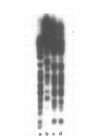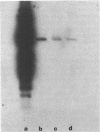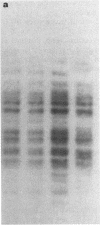Abstract
A repetitive element in C.elegans has been found that bears high homology to the element mariner of Drosophila mauritiana (EMBL accession number X77804). This element is present in about 20 copies in the N2 strain of C.elegans, and appears in roughly equal copy numbers in the related strain BO and in the hybrid strains RW7097 and TR679. There is only one copy of this MLE in three related species of Caenorhabditis. A cDNA of this mariner-like element (MLE) codes for a protein with 58% homology to the Drosophila transposase. The mariner-like element is not mobile in N2. This class of elements has now been described in insects, planaria and nematodes (GenBank accession number M98552 and this report).
Full text
PDF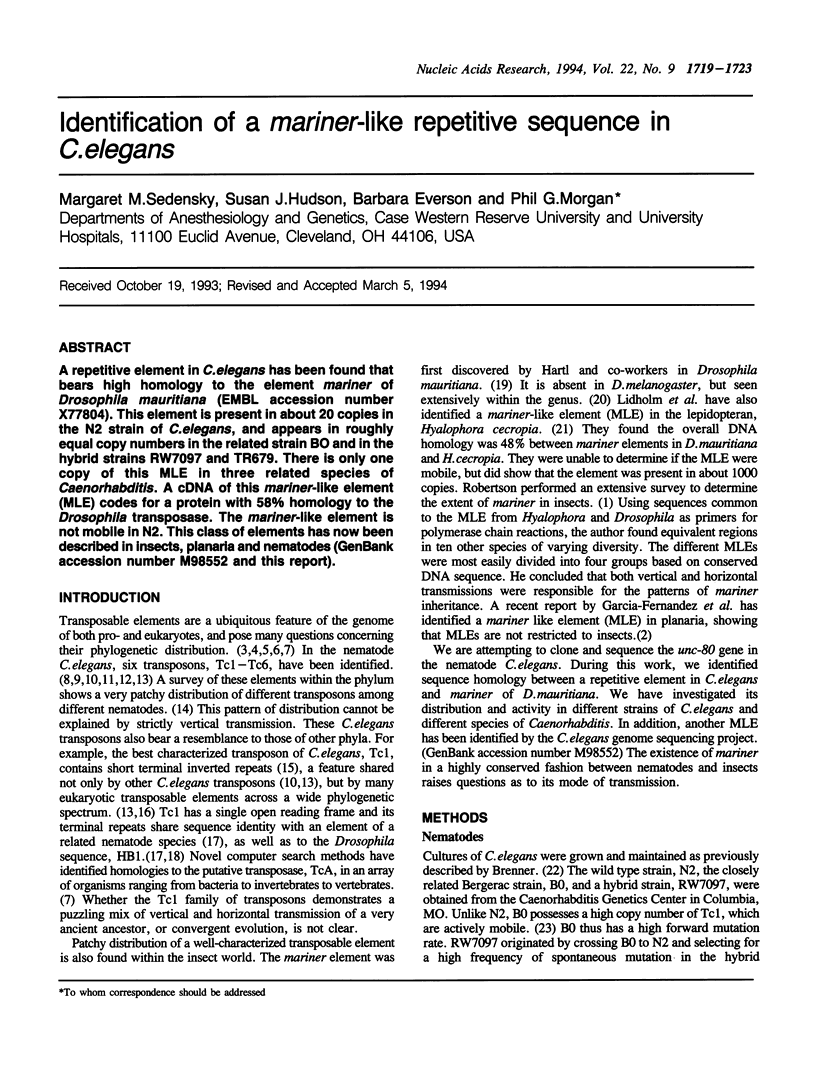
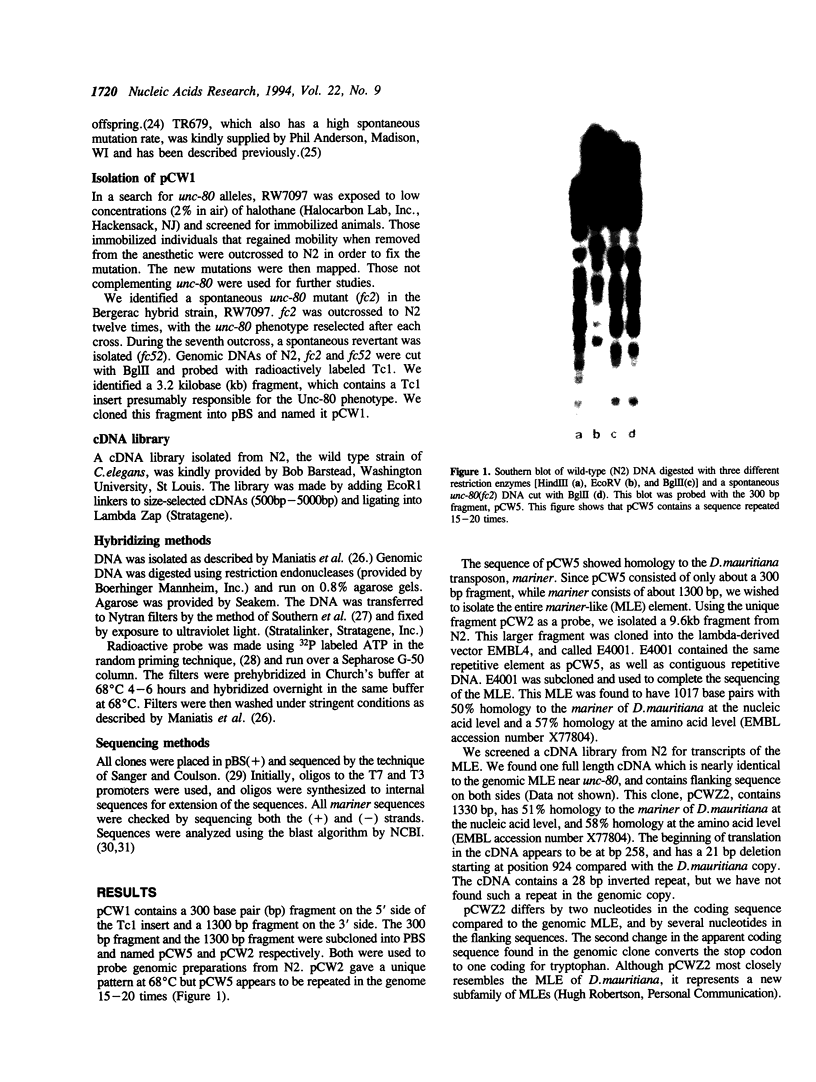
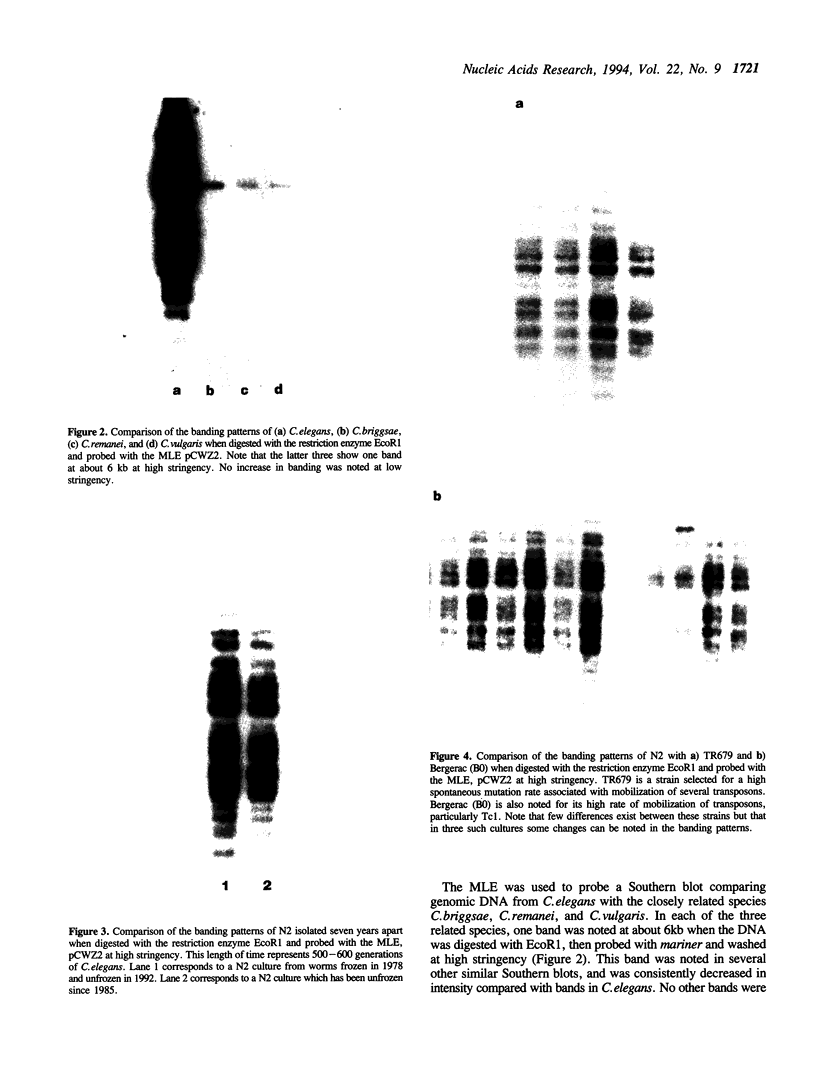
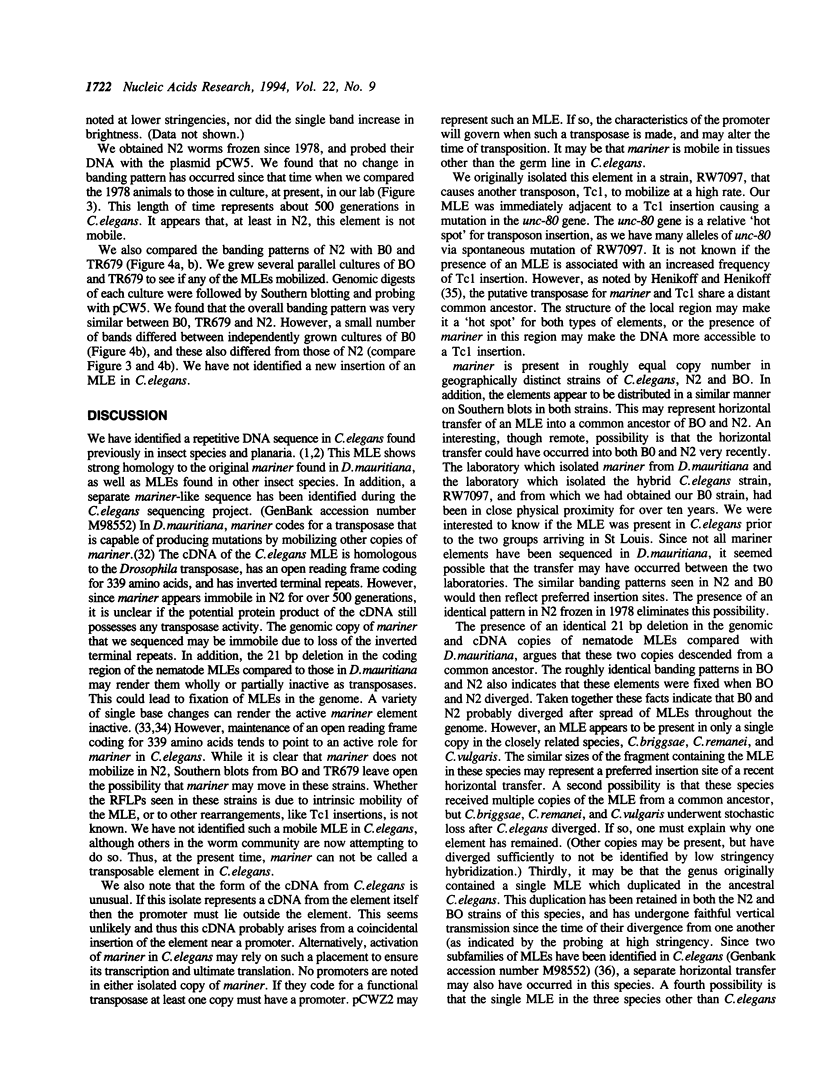

Images in this article
Selected References
These references are in PubMed. This may not be the complete list of references from this article.
- Abad P., Quiles C., Tares S., Piotte C., Castagnone-Sereno P., Abadon M., Dalmasso A. Sequences homologous to Tc(s) transposable elements of Caenorhabditis elegans are widely distributed in the phylum nematoda. J Mol Evol. 1991 Sep;33(3):251–258. doi: 10.1007/BF02100676. [DOI] [PubMed] [Google Scholar]
- Altschul S. F., Gish W., Miller W., Myers E. W., Lipman D. J. Basic local alignment search tool. J Mol Biol. 1990 Oct 5;215(3):403–410. doi: 10.1016/S0022-2836(05)80360-2. [DOI] [PubMed] [Google Scholar]
- Brenner S. The genetics of Caenorhabditis elegans. Genetics. 1974 May;77(1):71–94. doi: 10.1093/genetics/77.1.71. [DOI] [PMC free article] [PubMed] [Google Scholar]
- Collins J., Forbes E., Anderson P. The Tc3 family of transposable genetic elements in Caenorhabditis elegans. Genetics. 1989 Jan;121(1):47–55. doi: 10.1093/genetics/121.1.47. [DOI] [PMC free article] [PubMed] [Google Scholar]
- Collins J., Saari B., Anderson P. Activation of a transposable element in the germ line but not the soma of Caenorhabditis elegans. Nature. 1987 Aug 20;328(6132):726–728. doi: 10.1038/328726a0. [DOI] [PubMed] [Google Scholar]
- Daniels S. B., Peterson K. R., Strausbaugh L. D., Kidwell M. G., Chovnick A. Evidence for horizontal transmission of the P transposable element between Drosophila species. Genetics. 1990 Feb;124(2):339–355. doi: 10.1093/genetics/124.2.339. [DOI] [PMC free article] [PubMed] [Google Scholar]
- Dreyfus D. H., Emmons S. W. A transposon-related palindromic repetitive sequence from C. elegans. Nucleic Acids Res. 1991 Apr 25;19(8):1871–1877. doi: 10.1093/nar/19.8.1871. [DOI] [PMC free article] [PubMed] [Google Scholar]
- Eide D., Anderson P. Transposition of Tc1 in the nematode Caenorhabditis elegans. Proc Natl Acad Sci U S A. 1985 Mar;82(6):1756–1760. doi: 10.1073/pnas.82.6.1756. [DOI] [PMC free article] [PubMed] [Google Scholar]
- Garcia-Fernàndez J., Marfany G., Baguñ J., Saló E. Infiltration of mariner elements. Nature. 1993 Jul 8;364(6433):109–110. doi: 10.1038/364109a0. [DOI] [PubMed] [Google Scholar]
- Garza D., Medhora M., Koga A., Hartl D. L. Introduction of the transposable element mariner into the germline of Drosophila melanogaster. Genetics. 1991 Jun;128(2):303–310. doi: 10.1093/genetics/128.2.303. [DOI] [PMC free article] [PubMed] [Google Scholar]
- Gish W., States D. J. Identification of protein coding regions by database similarity search. Nat Genet. 1993 Mar;3(3):266–272. doi: 10.1038/ng0393-266. [DOI] [PubMed] [Google Scholar]
- Harris L. J., Baillie D. L., Rose A. M. Sequence identity between an inverted repeat family of transposable elements in Drosophila and Caenorhabditis. Nucleic Acids Res. 1988 Jul 11;16(13):5991–5998. doi: 10.1093/nar/16.13.5991. [DOI] [PMC free article] [PubMed] [Google Scholar]
- Harris L. J., Prasad S., Rose A. M. Isolation and sequence analysis of Caenorhabditis briggsae repetitive elements related to the Caenorhabditis elegans transposon Tc1. J Mol Evol. 1990 Apr;30(4):359–369. doi: 10.1007/BF02101890. [DOI] [PubMed] [Google Scholar]
- Henikoff S. Detection of Caenorhabditis transposon homologs in diverse organisms. New Biol. 1992 Apr;4(4):382–388. [PubMed] [Google Scholar]
- Henikoff S., Henikoff J. G. Amino acid substitution matrices from protein blocks. Proc Natl Acad Sci U S A. 1992 Nov 15;89(22):10915–10919. doi: 10.1073/pnas.89.22.10915. [DOI] [PMC free article] [PubMed] [Google Scholar]
- Henikoff S., Plasterk R. H. Related transposons in C.elegans and D.melanogaster. Nucleic Acids Res. 1988 Jul 11;16(13):6234–6234. doi: 10.1093/nar/16.13.6234. [DOI] [PMC free article] [PubMed] [Google Scholar]
- Jacobson J. W., Medhora M. M., Hartl D. L. Molecular structure of a somatically unstable transposable element in Drosophila. Proc Natl Acad Sci U S A. 1986 Nov;83(22):8684–8688. doi: 10.1073/pnas.83.22.8684. [DOI] [PMC free article] [PubMed] [Google Scholar]
- Levitt A., Emmons S. W. The Tc2 transposon in Caenorhabditis elegans. Proc Natl Acad Sci U S A. 1989 May;86(9):3232–3236. doi: 10.1073/pnas.86.9.3232. [DOI] [PMC free article] [PubMed] [Google Scholar]
- Liao L. W., Rosenzweig B., Hirsh D. Analysis of a transposable element in Caenorhabditis elegans. Proc Natl Acad Sci U S A. 1983 Jun;80(12):3585–3589. doi: 10.1073/pnas.80.12.3585. [DOI] [PMC free article] [PubMed] [Google Scholar]
- Maruyama K., Hartl D. L. Evolution of the transposable element mariner in Drosophila species. Genetics. 1991 Jun;128(2):319–329. doi: 10.1093/genetics/128.2.319. [DOI] [PMC free article] [PubMed] [Google Scholar]
- Maruyama K., Schoor K. D., Hartl D. L. Identification of nucleotide substitutions necessary for trans-activation of mariner transposable elements in Drosophila: analysis of naturally occurring elements. Genetics. 1991 Aug;128(4):777–784. doi: 10.1093/genetics/128.4.777. [DOI] [PMC free article] [PubMed] [Google Scholar]
- Medhora M., Maruyama K., Hartl D. L. Molecular and functional analysis of the mariner mutator element Mos1 in Drosophila. Genetics. 1991 Jun;128(2):311–318. doi: 10.1093/genetics/128.2.311. [DOI] [PMC free article] [PubMed] [Google Scholar]
- Mori I., Moerman D. G., Waterston R. H. Analysis of a mutator activity necessary for germline transposition and excision of Tc1 transposable elements in Caenorhabditis elegans. Genetics. 1988 Oct;120(2):397–407. doi: 10.1093/genetics/120.2.397. [DOI] [PMC free article] [PubMed] [Google Scholar]
- Robertson H. M., Lampe D. J., MacLeod E. G. A mariner transposable element from a lacewing. Nucleic Acids Res. 1992 Dec 11;20(23):6409–6409. doi: 10.1093/nar/20.23.6409. [DOI] [PMC free article] [PubMed] [Google Scholar]
- Robertson H. M. The mariner transposable element is widespread in insects. Nature. 1993 Mar 18;362(6417):241–245. doi: 10.1038/362241a0. [DOI] [PubMed] [Google Scholar]
- Rosenzweig B., Liao L. W., Hirsh D. Sequence of the C. elegans transposable element Tc1. Nucleic Acids Res. 1983 Jun 25;11(12):4201–4209. doi: 10.1093/nar/11.12.4201. [DOI] [PMC free article] [PubMed] [Google Scholar]
- Sanger F., Coulson A. R., Barrell B. G., Smith A. J., Roe B. A. Cloning in single-stranded bacteriophage as an aid to rapid DNA sequencing. J Mol Biol. 1980 Oct 25;143(2):161–178. doi: 10.1016/0022-2836(80)90196-5. [DOI] [PubMed] [Google Scholar]
- Southern E. M. Detection of specific sequences among DNA fragments separated by gel electrophoresis. J Mol Biol. 1975 Nov 5;98(3):503–517. doi: 10.1016/s0022-2836(75)80083-0. [DOI] [PubMed] [Google Scholar]
- Voytas D. F., Konieczny A., Cummings M. P., Ausubel F. M. The structure, distribution and evolution of the Ta1 retrotransposable element family of Arabidopsis thaliana. Genetics. 1990 Nov;126(3):713–721. doi: 10.1093/genetics/126.3.713. [DOI] [PMC free article] [PubMed] [Google Scholar]
- Wichman H. A., Van den Bussche R. A., Hamilton M. J., Baker R. J. Transposable elements and the evolution of genome organization in mammals. Genetica. 1992;86(1-3):287–293. doi: 10.1007/BF00133727. [DOI] [PubMed] [Google Scholar]
- Wilke C. M., Maimer E., Adams J. The population biology and evolutionary significance of Ty elements in Saccharomyces cerevisiae. Genetica. 1992;86(1-3):155–173. doi: 10.1007/BF00133718. [DOI] [PubMed] [Google Scholar]
- Yuan J. Y., Finney M., Tsung N., Horvitz H. R. Tc4, a Caenorhabditis elegans transposable element with an unusual fold-back structure. Proc Natl Acad Sci U S A. 1991 Apr 15;88(8):3334–3338. doi: 10.1073/pnas.88.8.3334. [DOI] [PMC free article] [PubMed] [Google Scholar]



